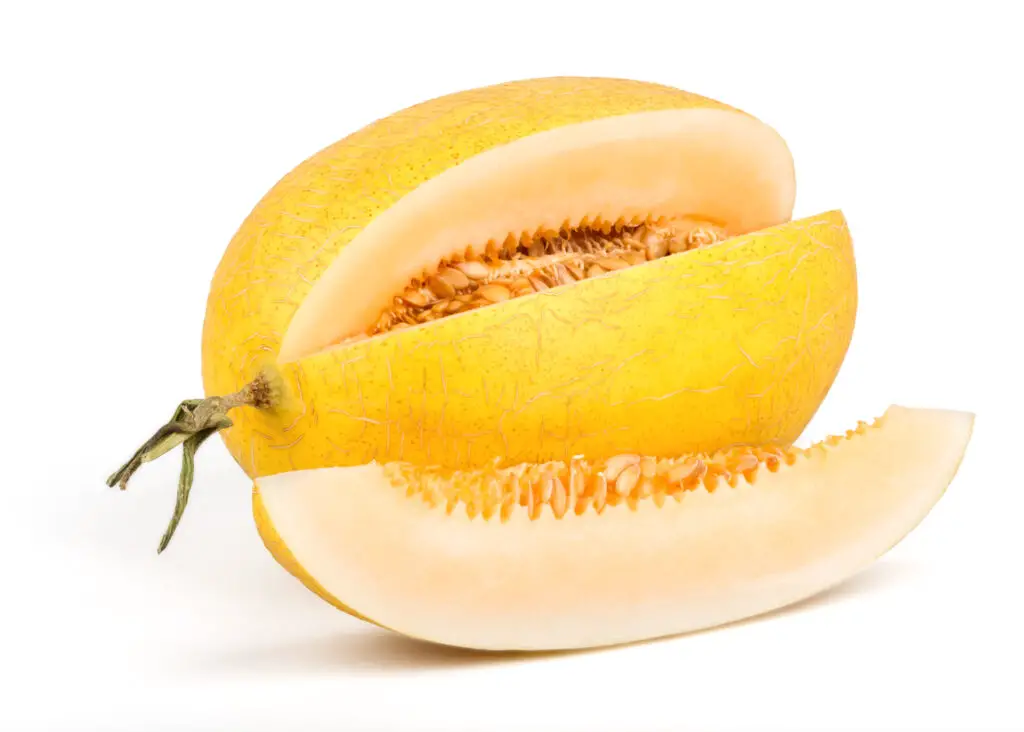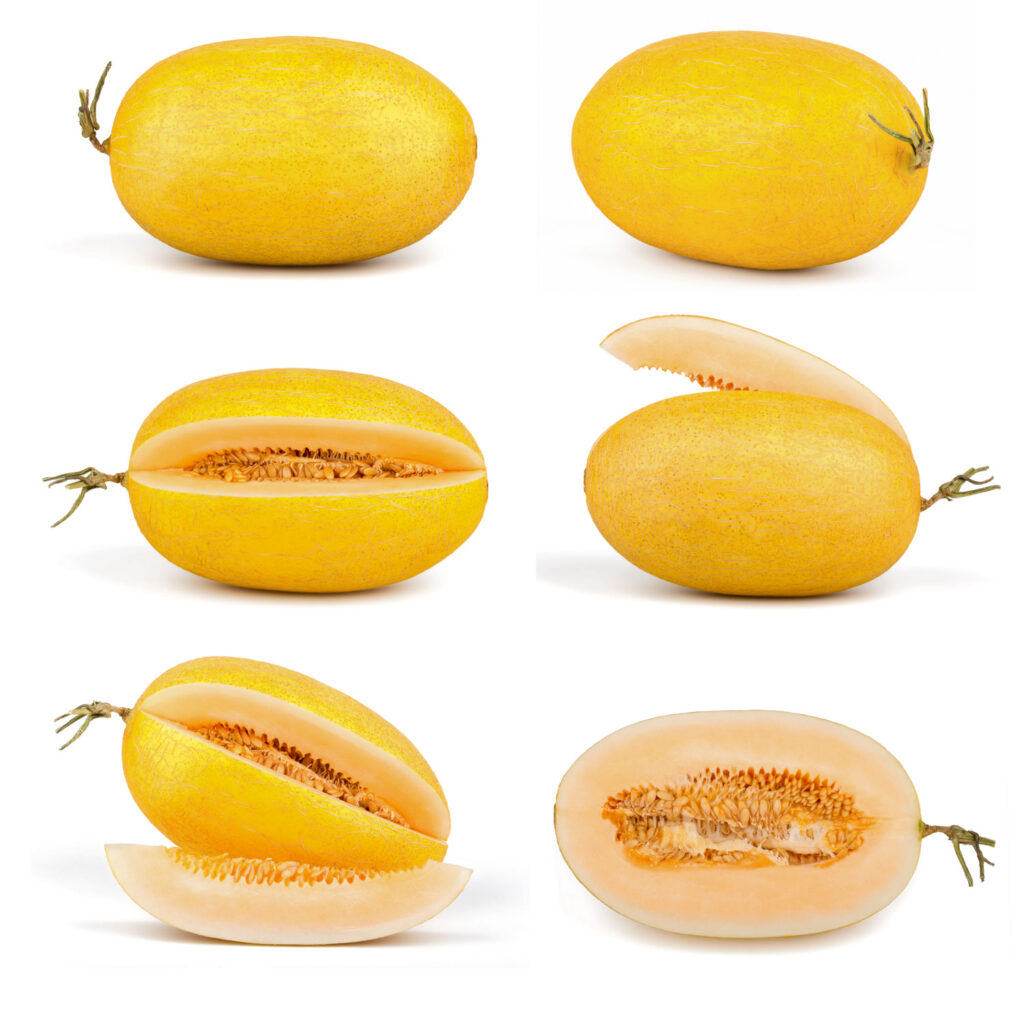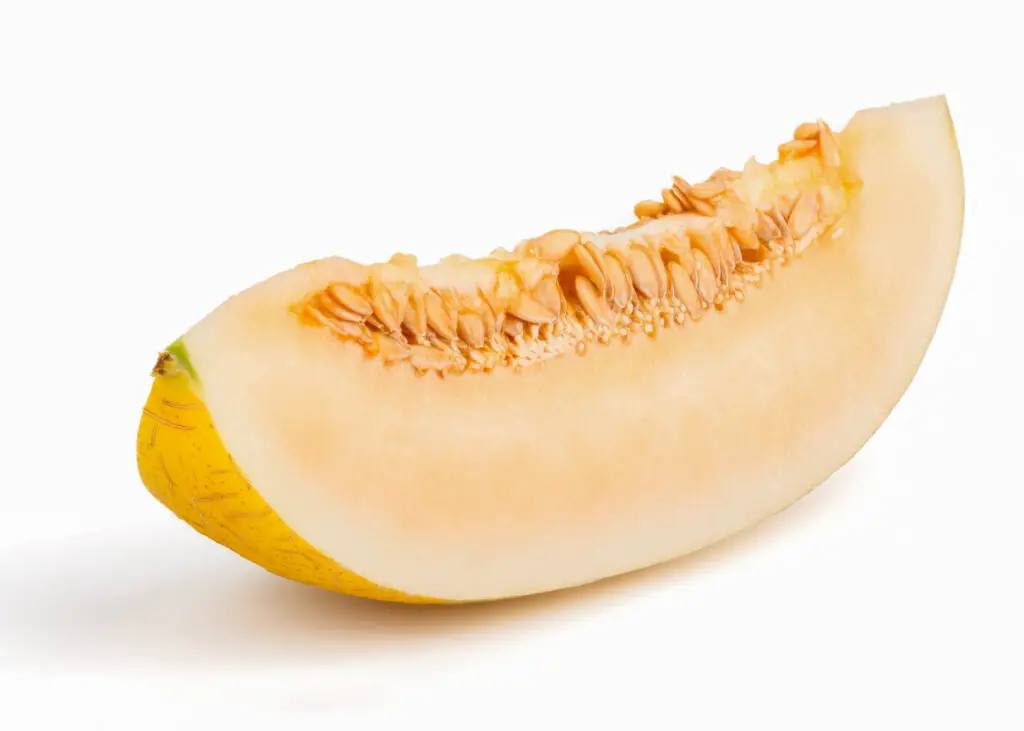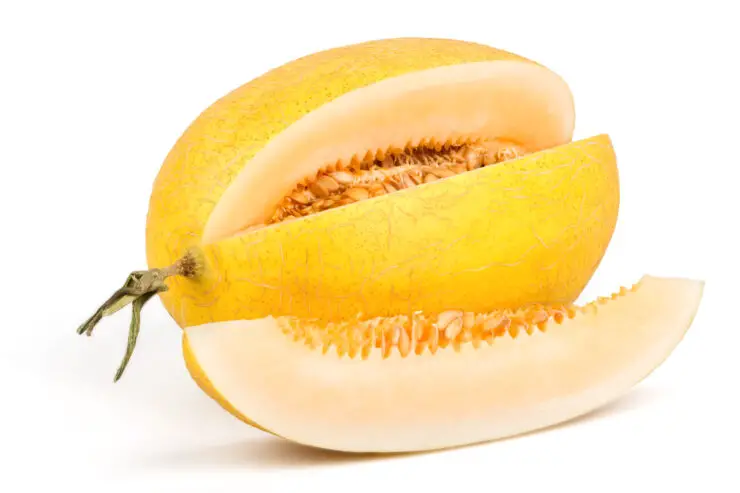As an Amazon Associate I earn from qualifying purchases. Please read the disclaimer for more info.
The Hami melon, also known as the snow melon, is a juicy, succulent, and aromatic fruit widely known for its sweet, honey-like taste and refreshing texture.
Originating from the Xinjiang region of China, the Hami melon is a unique and beloved fruit that has captivated many’s hearts (and taste buds).
Whether you’re a fan of melons or not, there’s no doubt that the Hami melon is a must-try fruit that deserves all the attention it gets.
Along with the Korean Melon, it is one of my favorite summer fruits.
What is Hami Melon?

The Hami Melon, also known as snow melon or Chinese Hami melon, is a juicy, delectable fruit from the Xinjiang province in China. With a round shape and beautiful yellow-green rind, the Hami melon is a feast for the eyes.
You’ll find fragrant, orange-hued flesh that’s sweet and crisp with a cool, juicy texture.
The melon is highly nutritious, packed with vitamins C and A, fiber, and potassium, making it an excellent addition to any healthy diet.
It’s widely known for its hydrating properties and is popular in hot climates where its juicy flesh and cooling effect are delightful.
Though originally from China, the Hami melon is now cultivated in various regions worldwide, including the United States and Japan.
This fruit is a true gem and one that’s worth trying.
Related: The Exotic and Nutritious Yellow Dragon Fruit
What is The History of The Golden Hami Melon?
The Hami melon has a rich history that dates back over 2,000 years. This prized fruit has been cultivated in China’s Xinjiang Uygur Autonomous Region, known for its fertile soil and unique climate.
This fruit was once a delicacy reserved for royalty due to its exceptional taste and unique aroma.
The Melon received its name from the Xinjiang city of Hami, where it was first cultivated.
Since then, it has traveled globally and is now enjoyed by people in many countries.
Related:
How Do You Eat Hami Melon?

Once you’ve cut open a Hami melon, you’ll find sweet, juicy orange flesh that’s both cool and crisp, with hints of honey flavor.
To enjoy this delicious melon, rinse it gently under cold water and dry it with a clean towel.
Then, cut the melon into halves using a sharp knife, and scoop out the seeds with a spoon.
Slice each half into wedges or cubes, and enjoy it fresh.
The sweet flavor of the melon pairs well with other types of fruit, such as strawberries, blueberries, or mangoes.
It also goes well as a topping for salads or fruit bowls.
The versatility of this melon makes it a great addition to any meal or snack, with its juicy, refreshing taste and health benefits!
What Does Hami Melon Taste Like?
When you take a bite of the Hami melon, you can expect a combination of flavors, including sweet, tangy, and slightly musky.
It is often compared to the taste of a cantaloupe but with a firmer texture and a more concentrated flavor.
Related: Top 20 Fruits in Zanzibar

What are the Health Benefits?
Hami melon not only tastes delicious but offers a range of health benefits too.
This fruit contains essential nutrients, including vitamin C, A, and potassium.
Eating this melon can help keep your immune system strong, promote healthy skin, and even reduce your risk of chronic diseases like heart disease and cancer.
Additionally, the high water content can help keep you hydrated, making it a perfect snack during the hot summer months.
Related: Explore The Delicious Fruits of Cambodia
Growing Hami Melon
Growing Hami melons can be a rewarding experience, but it’s important to remember a few tips.
- First, plant in full sun and fertile, well-draining soil.
- Hami melons need plenty of water but do not overwater as this can lead to root rot.
- Additionally, it’s a good idea to support the vines as the melons can get quite heavy.
With proper care, you’ll be able to enjoy your homegrown melons all summer long.
Ideas for Hami Melon Recipes
There are plenty of options if you’re looking for creative recipes beyond a fruit salad to add this delicious fruit to your meal repertoire.
One idea is to use thinly sliced pieces of melon to add a unique twist to your summer salad. Add some fresh mint and feta cheese for a refreshing flavor.
You can also try incorporating Hami melon into your smoothies, juice blends, or fruit punches for a refreshing boost of nutrients.
A simple way to enjoy the sweetness of the crunchy melon with a touch of sourness is to squeeze lemon or lime juice over the fruit or mix up the flavors with a touch of ginger or salt.
Related Fruit Recipes:

Conclusion
Now that you know about the amazing Hami melon, why not try it in your next meal or recipe? Whether you enjoy this fruit on its own or mix it with other varieties of melons such as the canteloupe or the honeydew melon.
We’ve got plenty of other fruits to explore, so why not look at our selection of tropical or citrus fruits for more delicious inspiration? Click one of the links above for even more fruity knowledge!
- African Pear: The Unique African Fruit
- Fruits of Vietnam: A Guide to Eating Vietnamese Fruit
- 17 Tropical Fruits You Need to Try
- Vietnamese Star Apple
FAQs
On average, a Hami melon will take about 80-90 days from planting to harvest.
In the spring and summer, you can typically find Hami Melons in specialty grocery stores or farmer’s markets. If unavailable, it may be worth a search through online retailers.
When choosing a Hami melon, look for one that has an even yellow-green color on its skin, with no spots or blemishes. Additionally, the melon should be heavy for its size and have a sweet, fragrant aroma. To test ripeness, press lightly on the skin of the melon – if it yields to your touch slightly, then it is ripe and ready to eat!
Although both are members of the Melon family, they differ in several ways. While cantaloupes have more orange flesh, Hami melons have light to pale-colored flesh.
Regarding taste, Hami melons are sweeter than cantaloupes and have a crunchier texture, with cantaloupes having a delicate, floral flavor and scent.
Yes, Hami melons are grown in the US. Although the origin is from China, the seeds have been carried to other parts of the world and are now regularly grown in North America.
Hami melon is typically grown in warmer areas such as California and Texas, although it can also be found in states like Oregon and Washington.
Yes, the Hami melon is a hybrid fruit. It was created by crossing two species of melon: Cucumis melo and Cucumis Charente. The result was a sweet-tasting, juicy fruit with a unique flavor and texture. Hami melons can now be found in many parts of the world, including North America and Europe.
No, Hami melons do not ripen after picking. It is important to choose a ripe melon when shopping for them at the store or market. Look for one with yellow skin, thin green streaks, and a fragrant aroma. Press lightly on the skin – if it yields slightly to your touch, it is ripe and ready to eat! Store the melon in a cool, dry place for up to a week. Cut the melon into cubes or slices for longer storage and freeze it for up to six months.

